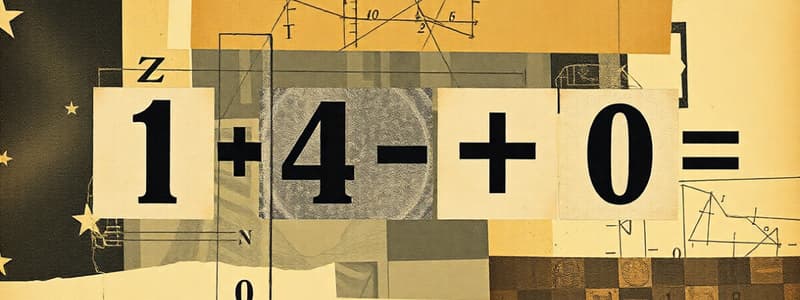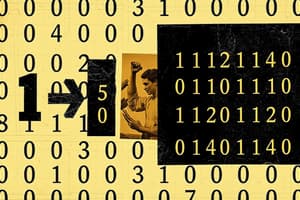Podcast
Questions and Answers
Which of the following shapes has both equal sides and equal angles?
Which of the following shapes has both equal sides and equal angles?
- Scalene triangle
- Isosceles triangle
- Right triangle
- Equilateral triangle (correct)
What is the total area of a rectangle with a length of 8 cm and a width of 5 cm?
What is the total area of a rectangle with a length of 8 cm and a width of 5 cm?
- 50 cm²
- 40 cm² (correct)
- 30 cm²
- 60 cm²
If the mean of the following set of numbers is 10, what is the total of the numbers if there are 5 numbers in the set? The numbers are: 8, 12, 10, X, 14.
If the mean of the following set of numbers is 10, what is the total of the numbers if there are 5 numbers in the set? The numbers are: 8, 12, 10, X, 14.
- 70
- 80
- 60 (correct)
- 50
Which of the following angles is classified as obtuse?
Which of the following angles is classified as obtuse?
In which of the following situations would you be using milliliters as a unit of measurement?
In which of the following situations would you be using milliliters as a unit of measurement?
What is the perimeter of a triangle with sides measuring 7 cm, 5 cm, and 3 cm?
What is the perimeter of a triangle with sides measuring 7 cm, 5 cm, and 3 cm?
If you divide 3.6 by 0.9, what is the quotient?
If you divide 3.6 by 0.9, what is the quotient?
Which unit would be most appropriate for measuring the distance of a marathon?
Which unit would be most appropriate for measuring the distance of a marathon?
What is the mode of the following set of numbers: 4, 1, 2, 2, 4, 2, 5?
What is the mode of the following set of numbers: 4, 1, 2, 2, 4, 2, 5?
Which of the following represents parallel lines?
Which of the following represents parallel lines?
What is the correct expanded form of the number 2,456?
What is the correct expanded form of the number 2,456?
Which of the following sets contains only prime numbers?
Which of the following sets contains only prime numbers?
Which property of multiplication states that the grouping of factors does not affect the product?
Which property of multiplication states that the grouping of factors does not affect the product?
When comparing the fractions 3/4 and 2/3, which is greater?
When comparing the fractions 3/4 and 2/3, which is greater?
Which of the following represents the correct sum when using carrying in the addition of 456 + 789?
Which of the following represents the correct sum when using carrying in the addition of 456 + 789?
If a number is divided by 1, what is the result?
If a number is divided by 1, what is the result?
What is the result of multiplying 8 by 100?
What is the result of multiplying 8 by 100?
Which of the following best describes composite numbers?
Which of the following best describes composite numbers?
How can you convert the fraction 1/2 into a decimal?
How can you convert the fraction 1/2 into a decimal?
Which number is a multiple of both 3 and 4?
Which number is a multiple of both 3 and 4?
Flashcards
Perpendicular lines
Perpendicular lines
A straight line that cuts through another straight line at a 90 degree angle.
Perimeter
Perimeter
The total length of all the sides of a two-dimensional shape added together.
Area
Area
The amount of space a two-dimensional shape covers.
Comparing decimals
Comparing decimals
Signup and view all the flashcards
Ordering decimals
Ordering decimals
Signup and view all the flashcards
Adding and Subtracting Decimals
Adding and Subtracting Decimals
Signup and view all the flashcards
Multiplying Decimals
Multiplying Decimals
Signup and view all the flashcards
Dividing Decimals
Dividing Decimals
Signup and view all the flashcards
Hexagon
Hexagon
Signup and view all the flashcards
Triangle
Triangle
Signup and view all the flashcards
Place Value
Place Value
Signup and view all the flashcards
Expanded Form
Expanded Form
Signup and view all the flashcards
Roman Numerals
Roman Numerals
Signup and view all the flashcards
Factors
Factors
Signup and view all the flashcards
Multiples
Multiples
Signup and view all the flashcards
Prime Numbers
Prime Numbers
Signup and view all the flashcards
Composite Numbers
Composite Numbers
Signup and view all the flashcards
Commutative Property of Addition
Commutative Property of Addition
Signup and view all the flashcards
Associative Property of Multiplication
Associative Property of Multiplication
Signup and view all the flashcards
Identity Property of Addition
Identity Property of Addition
Signup and view all the flashcards
Study Notes
Number System
- Place value: Understanding the value of a digit based on its position in a number.
- Expanded form: Expressing a number as the sum of the values of its digits.
- Roman numerals: A system of numerical notation using letters (I, V, X, L, C, D, M).
- Comparing numbers: Determining the relative size of numbers using symbols like <, >, and =.
- Rounding off numbers: Approximating a number to a specified place value.
- Estimation: Finding an approximate value for a calculation, often using rounding.
- Factors: Numbers that divide another number evenly.
- Multiples: Numbers that are products of another number.
- Prime numbers: Numbers greater than 1 that have only two factors, 1 and themselves.
- Composite numbers: Numbers greater than 1 that have more than two factors.
- Identifying patterns in number sequences.
Addition and Subtraction
- Properties of addition: Commutative property (order doesn't matter), associative property (grouping doesn't matter), identity property (adding zero doesn't change the number).
- Properties of subtraction: Subtraction does not have the same commutative and associative properties as addition.
- Word problems involving addition and subtraction.
- Estimating sums and differences.
- Carrying and borrowing in multi-digit addition and subtraction.
Multiplication
- Multiplication facts: Memorizing multiplication tables.
- Multiplying by 10, 100, and 1000 and their multiples.
- Multiplication properties: Commutative property (order doesn't matter), associative property (grouping doesn't matter), distributive property (multiplying a sum), identity property (multiplying by 1).
- Word problems involving multiplication.
- Multiplying multi-digit numbers.
- Estimating products.
Division
- Division facts: Memorizing division facts.
- Division by 10, 100, and 1000.
- Division properties: Division by 1 is the number itself, division of 0 is 0, and division of a number by itself is 1.
- Word problems involving division.
- Long division.
- Estimating quotients.
Fractions
- Understanding fractions as parts of a whole.
- Equivalent fractions: Fractions that represent the same part of a whole.
- Comparing and ordering fractions.
- Addition and subtraction of like fractions.
- Addition and subtraction of unlike fractions.
- Multiplication of fractions by whole numbers and fractions by fractions.
- Conversions between fractions, decimals, and percentages (introduction).
Decimals
- Understanding decimals as parts of a whole.
- Place value in decimals.
- Comparing and ordering decimals.
- Addition and subtraction of decimals.
- Multiplication and division of decimals (by whole numbers and other decimals in limited cases).
Geometry
- Shapes: Identifying and classifying 2D shapes (triangles, quadrilaterals, circles, and other polygons).
- Understanding 3D shapes (cubes, cuboids, cylinders, cones, spheres).
- Lines: Identifying parallel, perpendicular, intersecting lines.
- Angles: Identifying acute, obtuse, right, and straight angles.
- Perimeter: Finding the distance around a 2D shape.
- Area: Finding the space enclosed by a 2D shape.
Measurement
- Units of length (millimeters, centimeters, meters, kilometers).
- Units of weight/mass (grams, kilograms).
- Units of capacity (milliliters, liters).
- Telling time (analog and digital clocks).
- Temperature (Celsius).
- Basic conversions between units.
Data Handling
- Collecting data.
- Organizing data using tables and charts (pictographs, bar graphs).
- Interpreting data presented in charts.
- Understanding mean, median, and mode as measures of central tendency.
Studying That Suits You
Use AI to generate personalized quizzes and flashcards to suit your learning preferences.




